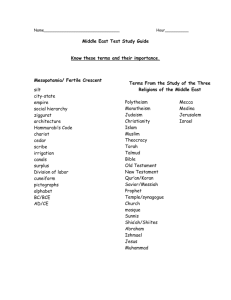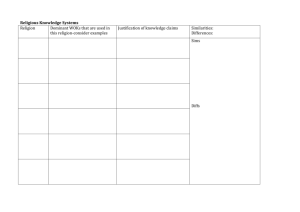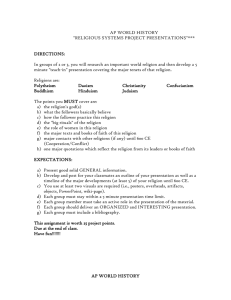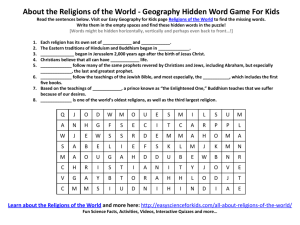World Religions Beliefs and Daily Life, Grade 11, Open
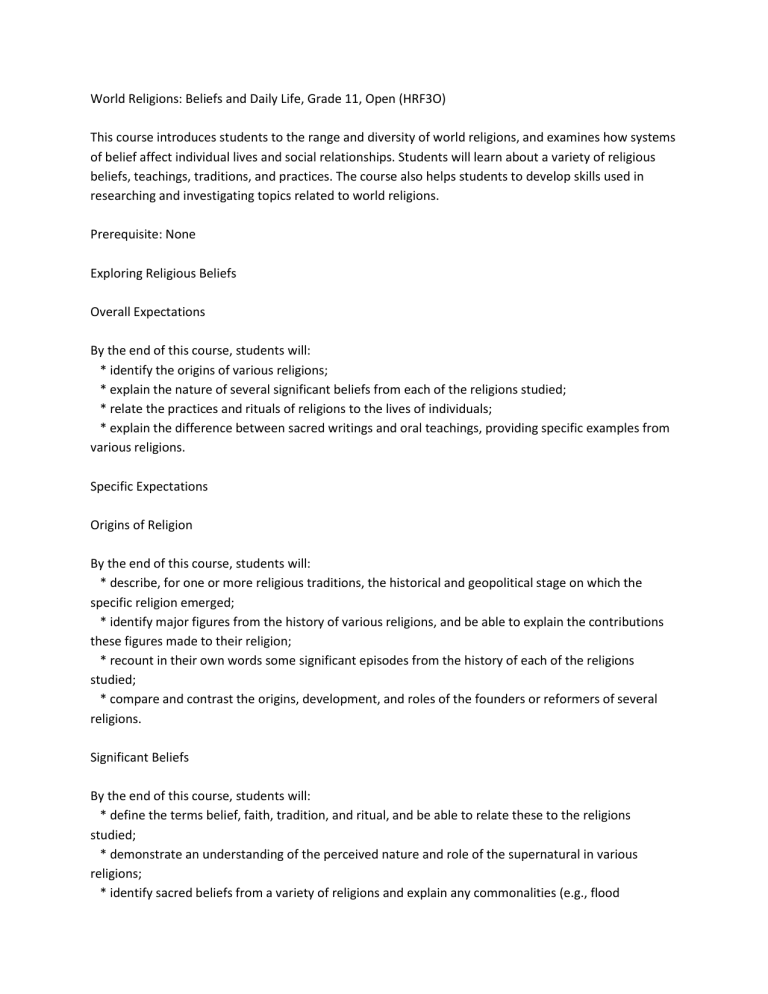
World Religions: Beliefs and Daily Life, Grade 11, Open (HRF3O)
This course introduces students to the range and diversity of world religions, and examines how systems of belief affect individual lives and social relationships. Students will learn about a variety of religious beliefs, teachings, traditions, and practices. The course also helps students to develop skills used in researching and investigating topics related to world religions.
Prerequisite: None
Exploring Religious Beliefs
Overall Expectations
By the end of this course, students will:
* identify the origins of various religions;
* explain the nature of several significant beliefs from each of the religions studied;
* relate the practices and rituals of religions to the lives of individuals;
* explain the difference between sacred writings and oral teachings, providing specific examples from various religions.
Specific Expectations
Origins of Religion
By the end of this course, students will:
* describe, for one or more religious traditions, the historical and geopolitical stage on which the specific religion emerged;
* identify major figures from the history of various religions, and be able to explain the contributions these figures made to their religion;
* recount in their own words some significant episodes from the history of each of the religions studied;
* compare and contrast the origins, development, and roles of the founders or reformers of several religions.
Significant Beliefs
By the end of this course, students will:
* define the terms belief, faith, tradition, and ritual, and be able to relate these to the religions studied;
* demonstrate an understanding of the perceived nature and role of the supernatural in various religions;
* identify sacred beliefs from a variety of religions and explain any commonalities (e.g., flood
narratives, creation stories);
* describe some of the symbols of the various religions, and explain how and when they are used.
Practices and Rituals
By the end of this course, students will:
* explain the difference among ritual, habit, and custom, using examples of all three from various religions;
* compare and contrast the rituals and practices of various religions (e.g., holy days, dietary laws);
* describe the role and significance of fasts and feasts in several religious traditions;
* relate religious practices and rituals to specific historical incidents;
* critically examine the roles assigned to women by different religious traditions;
* demonstrate an understanding of the connections between symbols and practices in specific religions (e.g., in Catholicism, the Rosary; in Zoroastrianism, the symbolism of the Sudreh and Kusti as it relates to the Avesta; in Judaism, the mezuzah; in Native spirituality, the eagle feather).
Sacred Writings and Oral Teachings
By the end of this course, students will:
* explain the difference between sacred writings and oral teachings;
* identify and interpret the significance of specific passages from sacred writings or oral teachings from various religions;
* describe the importance of sacred writings and oral teachings in the various religions studied;
* compare and contrast the portrayals of women in the sacred texts of different religions.
Religion and Daily Life
Overall Expectations
By the end of this course, students will:
* demonstrate an understanding of religions whose beliefs and practices accommodate a range of commitment, from strict observance to liberal compromise;
* explain the impact of prejudices associated with, and misconceptions about, various religions, beliefs, and traditions;
* explain how religious beliefs, or a lack of them, can affect the ways in which individuals relate to others and address issues in daily life in Canada;
* analyse the role of practices and rituals in the daily lives of believers from various religious traditions;
* apply critical-thinking and problem-solving skills to personal situations, work situations, and social issues as they relate to the religious traditions or principles of various groups;
* analyse two or more of the global effects of religion.
Specific Expectations
Spectrum of Beliefs
By the end of this course, students will:
* demonstrate an understanding of the terms orthopraxy/orthodoxy, conservative, liberal, secularizing, reformist, fundamentalist, reconstructionist, and normative in the context of various religions;
* identify specific differences in interpretation of belief within religious communities (e.g., in
Christianity, the filioque clause);
* explain how variations in practice can cause divisions within a religion or religious community (e.g., the Taliban of Afghanistan);
* analyse the influence of concepts of morality and ethics in various religious traditions.
Beliefs, Prejudices, and Misconceptions
By the end of this course, students will:
* describe how misconceptions can influence people's views of various religions, beliefs, and practices;
* demonstrate an understanding of the concepts of prejudice, bias, and discrimination, and identify examples associated with various religions, beliefs, and practices;
* explain the effect of prejudice and discrimination on relationships between persons of different faiths, and apply problem-solving strategies to case studies of interreligious conflict;
* identify some areas in which relationships between people of different beliefs, traditions, and practices can create conflict (e.g., Aboriginal peoples' response to the encroachment of development on sacred sites);
* explain the difference between secularism and fundamentalism, and discuss the effect of both on relationships between persons of various faiths;
* analyse the concerns of women regarding their evolving roles in various religious institutions, traditions, and practices.
Practices and Rituals
By the end of this course, students will:
* demonstrate an understanding of meditation, prayer, fasting, and pilgrimage in various religious traditions;
* define mysticism, using examples from various traditions;
* categorize daily rituals employed by various religions (e.g., regular prayer, fasting);
* describe the main features of the places of worship of several distinct religions, demonstrating knowledge that might be gained by visiting a mosque, synagogue, temple, church, or meeting-house;
* analyse the difficulties that individuals who follow particular religious practices in regard to dress, diet, or behaviour may encounter living in Canadian society (e.g., wearing hejab, blood transfusions);
* describe how religious movements (e.g., Reform Judaism) or events (e.g., Second Vatican Council)
have led to changes in religious practice over the centuries.
Global Effects
By the end of this course, students will:
* demonstrate an understanding of the global dissemination of various religions;
* explain the concepts of ecumenism and interfaith dialogue;
* investigate the origins of the Parliament of World Religions and analyse the implications of its recent published statements;
* explain the concepts of "church" and "state" and investigate specific examples of societies in which these institutions are blended or distinct.
Exploring Festivals, Celebrations, and Memorializations
Overall Expectations
By the end of this course, students will:
* evaluate the importance of celebration and memorialization in human experience;
* describe the major festivals and commemorations of various religions;
* demonstrate an understanding of the origins of common celebrations and commemorations;
* analyse the effects of various religious celebrations on contemporary Canadian society;
* differentiate between popular and religious symbolism associated with festivals and celebrations derived from various religions.
Specific Expectations
By the end of this course, students will:
* identify and describe the observances associated with the major festivals, commemorations, and celebrations of various religions (e.g., the Tuvan "fire feast");
* demonstrate an understanding of the terminology associated with celebration, commemoration, and festivals in various religions (e.g., the K'uraka among the Yatiris of Bolivia);
* demonstrate an understanding of the importance of calendars and other cyclical calculations (e.g., jubilees) in the observance of various religions;
* evaluate the similarities and differences between civil and religious observances and celebrations
(e.g., oath of citizenship, marriage vows, pilgrimage, visit to Parliament Hill, Canada Day, Remembrance
Day, New Year's);
* analyse the diverse origins of symbols associated with specific civil and religious festivals, celebrations, and commemorations (e.g., flags, Advent wreath, menorah, Kara, Kusti, lotus, fireworks, sweetgrass, military displays);
* demonstrate the skills and knowledge necessary to relate symbols, scriptures, and works of art, music, or literature to festivals, celebrations, and commemorations.
Exploring the Milestones of Life
Overall Expectations
By the end of this course, students will:
* demonstrate an understanding of common features of individual human development across several cultures and historical eras;
* demonstrate an awareness of the rites of passage of the religions studied;
* demonstrate the skills and knowledge necessary to correlate rituals and beliefs, in regard to various religions.
Specific Expectations
By the end of this course, students will:
* identify the main stages of individual human development as perceived in various cultures and religious traditions (e.g., birth, rites of passage, marriage, death, afterlife);
* identify the origin of various rites of passage and demonstrate an understanding of the symbols, art, and literature associated with each;
* describe the connection between systems of belief and the celebrations associated with various rites of passage (e.g., circumcision, baptism, moksha, bar- and bat-mitzvah, bhakti, caste, Confirmation, ashrama, Pillars of Islam, Kesh, Sacred Thread Ceremony, vision quest);
* analyse the reasons why such observances may have changed over time, or in various places.
Research and Inquiry Skills
Overall Expectations
By the end of this course, students will:
* distinguish between fact and opinion, belief and religion, and theory and practice in the context of the study of religion;
* demonstrate the knowledge and skills necessary to use a variety of research methodologies in the study of religion;
* effectively communicate the results of individual or group research.
Specific Expectations
By the end of this course, students will:
* formulate appropriate research questions relating to the beliefs or practices of various religions;
* employ appropriate methods to research such questions in independent and collaborative studies;
* use primary and secondary sources appropriately in conducting research;
* employ appropriate interviewing skills in conducting an in-depth interview with an individual who has dedicated his or her life to a specific religion or belief system;
* effectively use the Internet or other electronic data-recovery systems as a tool in researching various topics in the study of religion;
* effectively communicate the results of their research, using a variety of forms and methods (e.g., written reports or essays, oral presentations, group presentations);
* prepare and deliver assignments, using various appropriate technological means.


